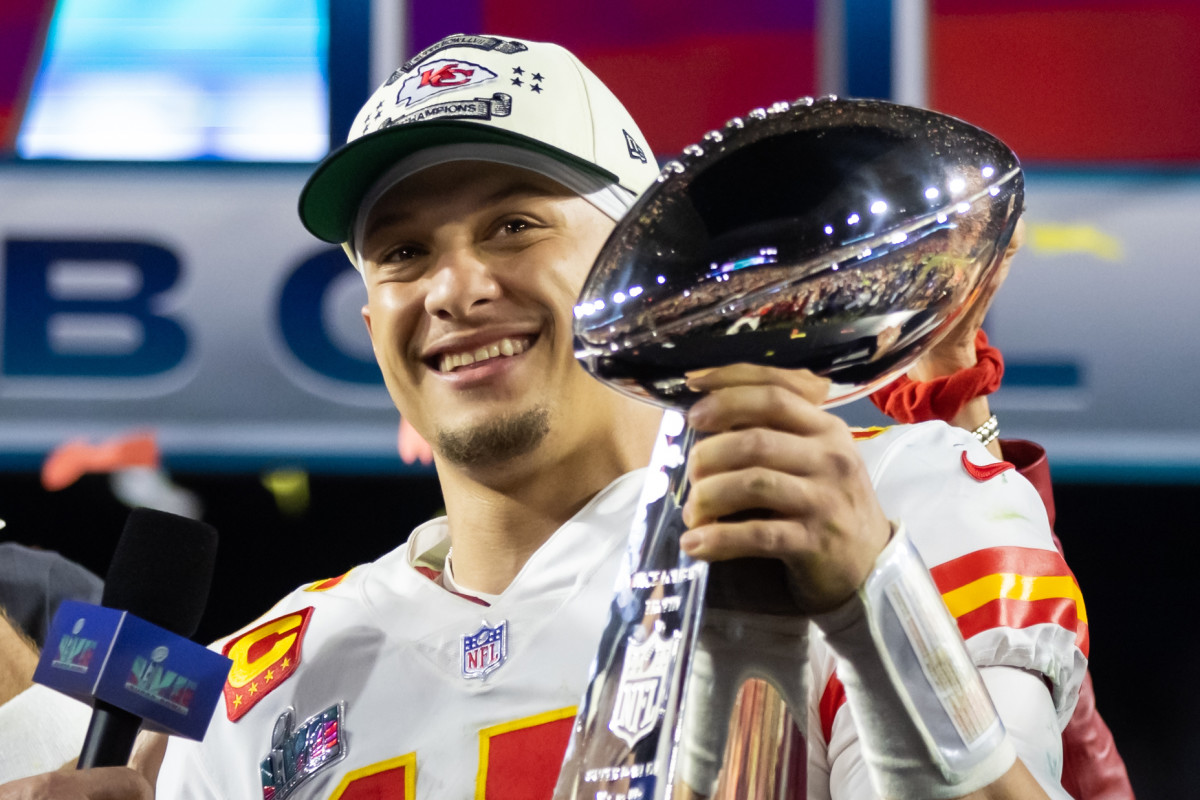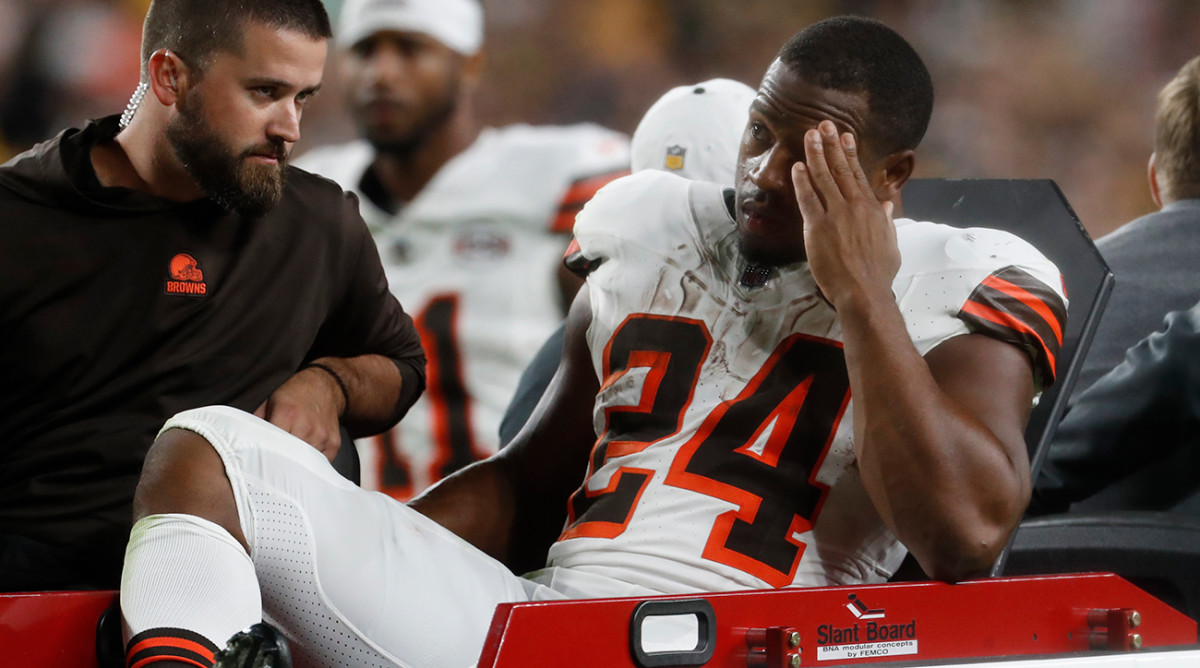Chiefs Had No Choice But to Adjust Patrick Mahomes’s Deal

As we get started, here’s to a fast and comfortable recovery for Nick Chubb. Tough to watch the Browns running back go down that way last night, especially considering just how well respected he is by just about everyone he’s been around. Here’s what we’ve got this Tuesday . . .
• The Chiefs didn’t have to do what they did in reworking Patrick Mahomes’s deal, effectively moving more than $43 million in the contract from its final five years to these next four years. They had him signed through 2031, and that’s why agent Chris Cabott had to be the one to broach the idea with Kansas City’s top negotiators in February, two days before Super Bowl LVII. And truth be told, the request he went to them with would be laughed out of the room in most cases.
This, of course, wasn’t most cases, because Mahomes isn’t most players.
Which is why Kansas City was more than willing to work with Cabott and the quarterback on revising the contract to reflect the NFL’s changing economic times.

So Mahomes’s camp may have needed to ask. But, of course, the Chiefs were going to do it, and they were going to do whatever they needed to keep Mahomes happy.
“That’s basically it,” says one Kansas City official, laughing while explaining the logic.
We had a full breakdown on the site Monday night, and I’d encourage any of you to read it if you’re interested in all the ins and outs of the deal. The bottom line is the Chiefs and Mahomes worked out a deal three years ago that they thought was built to change with the market—with his APY (average per year) doubling over the final six years of the 12-year deal, which added 10 years to the two left on his rookie contract.
Watch the Chiefs with Fubo. Start your free trial today.
Then, the market outpaced their projection (by a lot), and this offseason created a breaking point where the $50 million-per-year barrier was ripped through by Jalen Hurts, Justin Herbert, Lamar Jackson and Joe Burrow, with that number also sitting there as the average on the back half of Mahomes’s deal (2026–31). That, again, made it so the Chiefs almost had to do something.
And I’d say even still they feel pretty good about the investment.
• While we’re there, I’ve got a fun leftover from my conversation with USC assistant Kliff Kingsbury. The former Cardinals and Texas Tech coach was taking me through how coaching Johnny Manziel prepared him for working with Mahomes at his alma mater, and he ended up getting himself to an interesting comment that should resonate with NFL folks.
“It really solidified for me coaching Johnny [at Texas A&M]—if they get wildly successful to get to this level, and they’re playing on a high level, who am I to change it?” Kingsbury says. “They’re here because they played that style. That’s how they play. Let’s just try and make that style work for them, and help it anyway we can. Like I said, I’ve gotten to see two really extreme cases of it, and they were both really fun to coach because of it.
“And this one, there’s eerily uncanny similarities—it’s cool to watch.”
“This one” is reigning Heisman Trophy winner and USC quarterback Caleb Williams, whom Kingsbury is working with now. And if you think the Mahomes comps the Trojan quarterback is drawing are over the top, just know the one guy who’s coached both doesn’t shy away from that idea.
• There’s no sugarcoating it—Justin Fields hasn’t looked good for two weeks. So I figured the time was right to try and figure out what the tape is telling teams that are studying him. And the answers I got were pretty interesting.
“It’s a combination of a lot of things,” says one AFC exec. “Protection isn’t great, and when he does start getting hit, he starts to drop eyes. The biggest issue is he’s not seeing the field—he has guys open at times and doesn’t pull the trigger. On top of that, he’s had some misses. They’re actually probably doing too much, in terms of pass options. . . . It’s a good scheme. [Offensive coordinator] Luke [Getsy] was probably hoping he took the next steps in the pass game. There’s no rhythm in the offense right now because the quarterback can’t see it.”
Along those lines, another exec says he saw similarities over the past two weeks to where Fields was in his development during his rookie year under the previous staff.
“It’s trying to make him a pocket passer and not doing enough to get him out on the edges where he has easier throws, because he can hurt you with his running ability,” says the NFC exec. “Everyone’s gonna play him the same—keep him in the pocket and make him feel like the rush is closing. And then his eyes will come down and he can’t find open guys. And the offensive line is not good, so he will keep feeling pressure.”
So what’s the answer for Getsy and coach Matt Eberflus? First and foremost, it seems as if the big thing is what it’s always been for Fields—the Bears have to get him playing faster. And going back to college, he always played faster when the running game was working, and he knows where he’s going with the ball.
Of course, creating those circumstances for a quarterback is easier said than done.

• Chubb’s injury will, of course, be held up as another example of why teams won’t pay running backs—and it’s a fair point.
That said, let’s talk about what he’s really made. So he signed a three-year, $36 million extension in 2021. Since then, and through this year, he’ll have made $27.99 million over three seasons. If you subtract the $3.38 million he was due in 2021 before signing the deal, then you get $24.61 million.
That means he’s made $9.33 million per year in real dollars, or $12.31 million per year in new money—both of which are really affordable numbers for a guy making Chubb’s impact.
And that’s where I get a little annoyed at the argument here. No one in Cleveland, even with the knowledge that Chubb would miss almost this entire season, would look at that contract as a bad investment. The numbers are very manageable. So, yeah, if you’re going to pay that guy like a pass rusher or left tackle or top receiver, then it’d be regrettable.
But that’s not close to what we’re talking about at Chubb’s position.
• You can read the Rams’ declaration that they’re trying to figure things out with running back Cam Akers as an “offer us anything” call to the rest of the NFL. One rival executive sums Akers’s trade value up this way: “Zero.”
That’s not wholly on Akers. It’s just that what teams are seeing is a guy who simply hasn’t been the same as he was as a rookie—after tearing his Achilles during the summer of 2021. And a guy who fell out of favor with the staff in Los Angeles—though one of the guys who was part of that equation, Ra’Shaad Samples, is now gone—in 2022. And a guy playing a position where it’s too easy to find other answers.
It’d be great, of course, to see Akers regain his 2020 form. But it’s also understandable that teams are having a harder and harder time seeing where that’ll actually happen.
If you’re looking for a landing spot, Cleveland would be one to keep an eye on.
• Eagles GM Howie Roseman is always aggressive in addressing needs, and I’d say one area to watch for Philly in the coming weeks would be safety. Both of last year’s starters, C.J. Gardner-Johnson and Marcus Epps, are gone, and it’s one area rival teams have seen Philly take a noticeable step back in 2023.
• Colts QB Gardner Minshew played really well in Sunday’s win over Houston, completing 19-of-23 passes for 171 yards, a touchdown and a 112.1 rating. And that sure looks like a great investment of $3.5 million by Shane Steichen’s crew. Steichen, of course, was with Minshew in Philly, and knew he’d get a smart player who’d operate his offense at a high level and take completions. And the Colts have gotten all of that (they had to flip the run game upside-down mid-game Sunday) and a really good mentor for rookie Anthony Richardson.
• The Dolphins gave rookie scatback De’Von Achane his first carry (it went for five yards) Sunday in New England. He played a total of six snaps, which is six more than he played in Week 1 (he was inactive for the opener). So why should you care? Well, Achane is lightning fast, and electric in space, and could be a nightmare to deal with running underneath Tyreek Hill and Jaylen Waddle. So the fact that Mike McDaniel is working him in the lineup merits some mention, as I see it.
• Like everyone else, I love George Pickens’s potential, and Monday night illustrated why. Pickens, who had four catches for 127 yards and a touchdown, is an interesting case because he fell in the 2022 draft for mostly off-field (and some injury) reasons. Could this be another case in which the Steelers’ ability to cast a wide net because of Mike Tomlin’s ability to work with wayward prospects lands them a premier player? If he gets more consistent, it sure could be.
• The Panthers dropping to 0–2 does bring the idea of Brian Burns as a trade target to the fore—again. I don’t think Carolina has much intention of moving him—they were offered two first-round picks (one in 2024, the other in ’25) and a third-rounder for him last October and said no—but if the team doesn’t start winning soon, the calls on his availability will start. And signing him won’t get easier in the wake of what Nick Bosa got in San Francisco ($170 million over the next five years, including $122.5 million guaranteed). So that’s one to watch over the six weeks or so from now until the Oct. 31 trade deadline.
